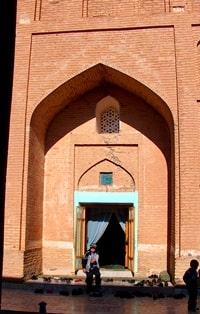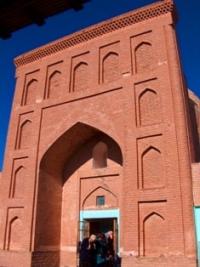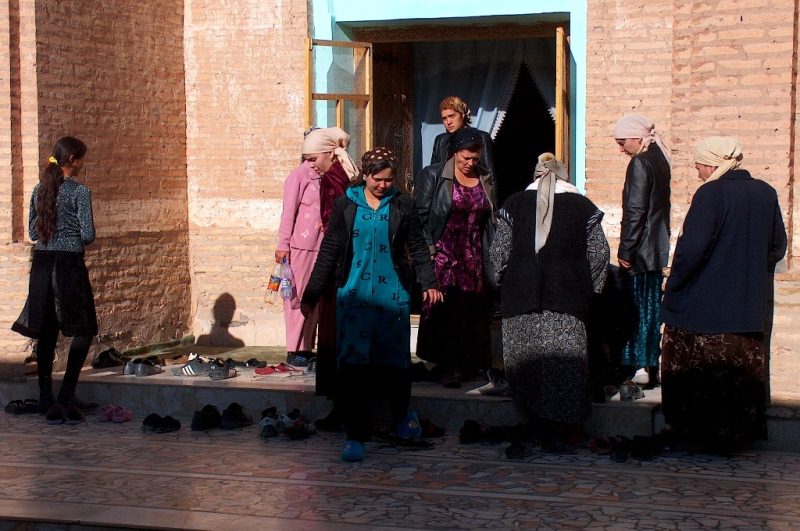Вы здесь
Sultan Uvais Mausoleum.


Travel to mausoleums of Karakalpakstan.
"Death is a peaceful sleep, a rest for the flesh, and life is insomnia addicted to caring."
Maarri al-Maarri.
Ancient monuments of Karakalpakstan.
The Sultan Uvais mausoleum is located on the southern slope of the Sultan-Uvais ridge, between the Kokralysay tracts in the east and Kazgansay in the west, from the south of the mausoleum there are low Kazantau mountains, 17 kilometers from the right (eastern) bank of the Amu Darya river, 8.8 kilometers to the north and a little to the west of the village of Kalandarkhan, 31.4 kilometers southeast of the village of Karatau in the Beruniy region of the Republic of Karakalpakstan.
The Sultan Weissa mausoleum is the only large mausoleum located on the territory of Karakalpakstan. The memorial monument dates back to the XIV century. The mausoleum is surrounded by massive mazars and a cemetery.
Sultan Bobo or Sultan Uvais is widely known in the Islamic world as Sultan Wais al-Qarani, at least according to the Arabic transliteration standard. His full name was Amir Saudinna Wais bin al-Qarani, and he was a simple camel herder from the village of Qaran in Yemen.
He was a contemporary of the Prophet Muhammad and is considered in some Islamic circles as the founder of the Islamic Sufi movement. Early Islamic records state that while living in Yemen, Wais al-Qarani internally received the teachings of the Prophet and became a devout Muslim.
He was inspired to travel to Medina to meet the Prophet Muhammad. His mother, who was blind, gave him permission to leave on the condition that he returned immediately as soon as he reached the Prophet's house.
After three months of travel, he arrived in Medina, but the prophet was not at home. True to his promise, he returned to Yemen. Despite this, Sultan Vais did not meet with the Prophet, He always came to him in a dream.
He often said, “I feel the breath of the Merciful who comes to me from Yemen.” Shortly before his death in 632, the Prophet ordered his two closest companions Omar (who later became the second caliph) and Ali (the husband of the Prophet's daughter Fatima) to take their cloak and give it to Wais in Yemen.
This laid the spiritual foundation of Wais al-Qarani in the Islamic faith. Although he did not have any special training, he was declared a saint and is revered by believers to this day. It is unlikely that Wais al-Qarani is buried in these mountains that bear his name today.
Similar tombs, associated by the name with Wais al-Qarani, can be found in two places in Syria, namely Damascus and Ar-Raqqa, and in another close to Zabid in Yemen. Vais probably died between 656 and 657.
The origins of the present mausoleum probably date back to the time of the arrival of the Sufi movement in Central Asia, around the 9th century AD. Ceramic finds from the mausoleum and the surrounding area suggest that the site was completely inhabited in the Xth century.
However, the current architectural structure was probably built around the XVIIth - XIXth centuries. In the 1920s and 30s, it was considered one of the holiest sites in Central Asia and was a popular pilgrimage site.
However, the mausoleum was officially closed in 1960 due to the suppression of religious beliefs. After the restructuring and collapse of the USSR, its popularity was restored, and now this place is widely popular as a pilgrimage and visiting tourists from various countries.
There is a large rectangular pool near the stairs leading to the mausoleum. The main part of the mausoleum was built of yellow baked bricks, the walls were whitewashed. The mausoleum and some neighboring buildings (mosque) have domes covered with square unglazed clay tiles.
The building itself is located inside a small courtyard. There is an open area for parking vehicles, and in the summer, merchants sell various souvenirs, amulets and other religious attributes. The restoration work of the mausoleum was completed in 2011. An asphalt road, steps, electricity supply.
Geographic coordinates of the Sultan Uvais mausoleum: N42 ° 00'43.93 "E60 ° 38'34.06"

Authority:
Dospanov October. “Improving the efficiency and sustainability of the functioning of the created Nizhne-Amudarya State Biosphere Reserve”. Nukus - Tashkent. 2013.
Photos by
Alexander Petrov.







